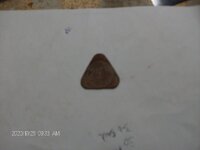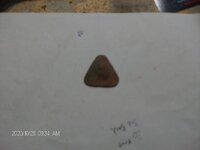I spent about 4 hours in the field today. Overcast and a cool wind made the windchill 43* I have mentioned we don't have much hunting time left as it is getting cool out. I spent 2 hours in a bean field that was a site of an 1875 school house. I dug an old can out of there and that was it! I went to another field that was supposed to be an old ball diamond. I went into the drive and started hunting with my trusty 600. Soon I got a good signal but it was reading a solid 18. I thought it may have been a shot shell or a green Indian head. I dug down 6" and popped out a metal object that was in the shape of a triangle. I looked at in and could make out 5 cents in trade! Put it in the pouch and found a shot shell and finally a 1941 merc. I may post pics tomorrow as I am tired. I always dig signals in a field that read between 18-21. I was running in Field 2,F2,iron bias 0 and sensitivity 24. My point I am trying to make is that some folk notch out numbers. Use your head and your machine wisely and you will find the good stuff! Ted
Find's Treasure Forums
Welcome to Find's Treasure Forums, Guests!
You are viewing this forums as a guest which limits you to read only status.
Only registered members may post stories, questions, classifieds, reply to other posts, contact other members using built in messaging and use many other features found on these forums.
Why not register and join us today? It's free! (We don't share your email addresses with anyone.) We keep email addresses of our users to protect them and others from bad people posting things they shouldn't.
Click here to register!
Need Support Help?
Cannot log in?, click here to have new password emailed to you
Changed email? Forgot to update your account with new email address? Need assistance with something else?, click here to go to Find's Support Form and fill out the form.
Are you missing coins?
- Thread starter Ted S
- Start date




